#indigo airlines news
Explore tagged Tumblr posts
Text
IndiGo and Japan Airlines Codeshare Partnership: Boosting India-Japan Connectivity
🌏✈️ Ready for seamless travel between India and Japan? IndiGo and Japan Airlines are teaming up with a new codeshare partnership starting December 16! This move promises to boost connectivity, business, and tourism between the two nations. Curious about how this impacts your travel plans? Click to find out more! #IndiGo #JapanAirlines #TravelNews #Aviation #IndiaJapan #AirTravel 🌐
#airlines#indigo airlines international#indigo airlines news#indigo airlines#indigo airlines a321#indigo airlines a320#indigo airlines a350#airline#indigo a350 order#indigo news#indigo airbus#indigo a350#indigo a320#indigo#share market for beginners#best channel for reasoning#race coaching institute#learn stock market in hindi#indian economy for upsc#29 april 2019 current affairs in hindi#current affairs in hindi
0 notes
Text
IndiGo Airlines new flights from Mangaluru, Coimbatore, and Tiruchirappalli to Abu Dhabi, starting August 2024 It hopes to boost South India to UAE connectivity
0 notes
Text
Understanding Aviation: Enemy's enemy is a friend
Recently, Air India announced the return to Kuala Lumpur with flights between Delhi and Kuala Lumpur starting September 01,2024. The timings favour connectivity to Europe via Delhi and eliminates the need of having double daily flights like in case of Phuket or only a good one way connectivity in the case of Ho Chi Minh City. I received quite a few messages asking me to mark this under…
#6E MH codeshare#AirAsia#AirAsia Bhd#India - Malaysia flights#Indian Aviation#Indian aviation blogs#Indian aviation news#Indian aviation updates#IndiGo#IndiGo Malaysia Airlines codeshare#IndiGo to Kuala Lumpur#Malaysia airlines#Understanding Aviation
0 notes
Text
IndiGo| goair | indigo airlines | airlines | indigo flight | indigo careers | indigo news
Indigo and Go First are getting the cheapest tickets of the year, get only 6139 International Flight chance Passengers can travel from March 12 to September 30, 2023। But for this you have to book tickets by 24 February Do you plan to roam this year? You do not have to worry because you are getting a chance to travel cheaply by September this year। Two of the country’s major airlines have…
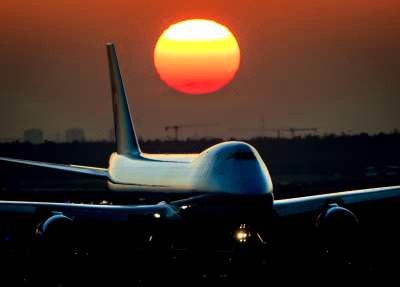
View On WordPress
0 notes
Text
Airlines flew 47 % more pax in 2022 vs 2021, but number still below pre-Covid - Times of India
MUMBAI: Domestic airlines transported 123 million passengers last year as against 83 million in the year 2021 thus registering an annual growth of 47 %, showed monthly traffic data released by the Directorate General of Civil Aviation (DGCA) on Thursday. But the number hasn’t crossed pre-Covid volumes as in the calendar year 2019, domestic airlines had flown 144 lakh passengers. For the month of…
View On WordPress
0 notes
Text
India’s $13.9 billion aviation industry—projected to cater to over 300 million domestically by 2030—is a ticking time bomb.
This July, in the sweltering heat at the Delhi High Court, additional solicitor general Aishwarya Bhati announced that new rules on pilot duty and rest periods would not be implemented this year after all. Introduced by the Directorate General of Civil Aviation (DGCA) in January, the rules were designed specifically to combat pilot fatigue. They were set to take effect in June, but were abruptly retracted. The hearing addressed a writ petition filed by the Federation of Indian Pilots (FIP), seeking clarity on when the new norms would be enforced. The DGCA’s response followed its request to airline companies in April for a tentative implementation timeline.
Concerns over pilot fatigue had been mounting in the months leading up to the announcement of the new Flight Duty Period, Flight Time Limitations, and Prescribed Rest Periods by the DGCA. The urgency deepened in November 2023 when a 37-year-old Air India pilot, Captain Himanil Kumar, collapsed at Delhi Airport while training to fly the airline's Boeing 777 fleet, and later died at the hospital. Kumar was the second Indian pilot to die on duty within three months; in August, Captain Manoj Subramanyam, a 40-year-old IndiGo pilot, suffered a fatal cardiac arrest just minutes before his flight from Nagpur.
These back-to-back tragedies raised alarm in the industry. “Another young Indian pilot passed away today due to a suspected cardiac event,” reportedly tweeted Captain Shakti Lumba, a retired IndiGo VP who is now the president of the Professional Pilots Society in India (His tweet was since deleted.) “If this doesn’t convince the DGCA, civil aviation ministry, and airlines to urgently address the stress, fatigue, and anxiety among pilots, nothing will.”
The DGCA, India’s aviation watchdog, regulates the country’s Flight Duty Time Limitations (FDTL). At 13 hours of flight duty time, India’s FDTL is already demanding, but after the pandemic slowdown, increased route expansion and pilot shortages have forced many to fly beyond the recommended maximum of 60 hours a week, exacerbating crew exhaustion. The DGCA finally responded to the growing crisis by revising FDTL norms in January 2024.
The new guidelines increased weekly rest periods from 36 to 48 hours and introduced quarterly fatigue reports. Its scheduled implementation on June 1, 2024, was pushed back due to pressure from operators. An airline CEO, speaking anonymously to the Economic Times in January, claimed the proposed regulations would require a 20 percent increase in pilot numbers, which would escalate expenses and lead to huge numbers of flight cancellations. Still, the DGCA held firm on the FDTL implementation deadline till early March. By the end of the month, however, it appeared to have yielded to influence from the airline lobby. A notice on the regulator’s website announced the deadline had been deferred, without providing a reason or setting a new date.
The pilot fatigue problem isn’t unique to India. In January, two pilots for Indonesia-based Batik Air fell asleep for 28 minutes mid-flight, causing their plane to veer off course between Sulawesi and Jakarta. In April, unionized Virgin Atlantic pilots in the UK voted 96 percent in favor of pursuing an industrial action in response to rising fatigue. Earlier, the CEO of Wizz Air UK faced a backlash for urging crew members to push through their fatigue to avoid flight cancellations. In May, senior pilots at Virgin Australia raised safety concerns, claiming rostering systems were pushing them "to the limits.”
But in India, the belief that overwork and fatigue are not just acceptable but essential has become entrenched across industries. The aviation crisis is just the tip of the iceberg; it is the tech industry that is leading the charge. Last year, Infosys cofounder Narayana Murthy suggested that Indian youth should work 70 hours a week for the nation's development. Murthy’s advice came up at the Indian Parliament on the first day of its winter session and found support from a list of influential Indian tech leaders, including Bhavish Aggarwal, founder of India’s first AI unicorn, Ola Krutrim; Ayushmaan Kapoor, cofounder of the AI-powered customer platform Xeno; and even veterans like Sajjan Jindal, CEO and MD of JSW Group, and Vinod Khosla of Sun Microsystems. Almost all of them justified the extended work hours, which far exceed the maximum eight to nine hours per day stipulated by the International Labour Organisation and the Indian Labour Code, as necessary for strengthening India’s economy. “We have to make India an economic superpower that we can all be proud of,” Jindal wrote on X. He cited Indian prime minister Narendra Modi, “who works 14-16 hours everyday,”as a model. In July this year, the Karnataka State IT/ITeS Employee Union said the state government had plans to increase working hours in the sector from the current maximum of 10 hours (including overtime) to a staggering 14 hours a day. As the union planned massive campaigns to oppose the move, the labor minister stated that the push for the proposal had come from the companies.
The airline companies think they have a solution to the fatigue crisis: technology. IndiGo, India’s largest airline, announced it would be an “early adopter” of a wrist-worn fatigue-monitoring device it was developing with French defense and aerospace company Thales Group. The device can provide “detailed insights into demographic data, including routes, pairings, crew profiles, and more, going beyond traditional scheduling-focused biomathematical models,” the airline stated in a press release in September. The airline, which operates 2,000 flights daily and employs over 5,000 pilots, said the device would be rolled out after a proof-of-concept trial. No date for the rollout was announced.
Wearable activity trackers are not new to the aviation industry. IndiGo’s device sounds similar to Actiwatch, a now-discontinued line of research-grade actigraphs from Philips, used to monitor sleep patterns, study circadian rhythms, and track physical activity as part of an airline’s fatigue risk-management system. But they partly rely on performance tests and subjective measures, such as self-reporting, which often results in being targeted by the airlines, says Captain C. S. Randhawa, president of the Federation of Indian Pilots. Safety management systems on the whole tend to be neglected by operators and are viewed as an additional expense, says Captain Amit Singh of the NGO Safety Matters Foundation.
In May 2023, Air India launched safety management software called Coruson, as well as BAM (Boeing Alertness Model), a fatigue-mitigation tool integrated into its rostering system, which is used by airlines to create and manage pilot schedules. Coruson, developed by cloud software company Ideagen, centralizes, analyzes, and reports on safety-related data—such as incidents, hazards, and risk assessments. BAM, developed jointly by Boeing and the software company Jeppesen, predicts and manages pilot fatigue by analyzing flight schedules and performance data. These tools were designed to prevent the creation of fatiguing rosters and pairings, Air India CEO Campbell Wilson noted in an internal message to employees. The carrier also introduced two new digital tools for its crew—the Pilot Sector Report app, to help pilots easily submit information on flight performance, incidents, and observations post-flight; and DocuNet, a digital management system that facilitates the storage, retrieval, and sharing of documents (such as flight manuals, training records, and compliance documents).
Despite these measures, the airline was fined by the DGCA in March this year for violating FDTL limits and fatigue management rules. This May, Air India Express cabin staff called in sick en masse to protest against “mismanagement.” This followed a similar protest from the crew, mostly pilots, at Vistara airlines. Both Air India and Vistara are now owned by one of India’s largest conglomerates, the Tata Group, which took over the former from the Indian government in January 2022.
Twenty-five of those who called in sick at Air India Express were terminated. Others were reportedly served an ultimatum. Those sacked were later reinstated by the airline following an intervention by the chief labour commissioner. Nearly a week before, the regional labor commissioner of Delhi had allegedly written to the Tata group chairman pointing to “blatant violations of labour laws” and insisting the legitimate concerns of the cabin crew be looked into. According to CNBC, Vistara employees said the agitation at their end had to do with recent salary updates, which fixed pilot pay at 40 flight hours—down from 70. Protesting first officers claimed that the new salary structure would result in an almost 57 percent pay cut. Under the new terms they would also have to fly up to 76 hours to earn what they were previously earning at 70 hours.
To placate the pilots and get them back to work, management had assured them that salaries for the “extra working hours” would be credited once Vistara was integrated with Air India. At the time, two Air India pilots unions had written to the chairman of the company, saying that such issues were not isolated but systemic. Burnout was the other related issue, with many pilots complaining of inadequate rest and being pushed to their limits.
Captain Singh, a former senior manager at AirAsia, tells WIRED that such effects significantly increase the risk of accidents, but also adversely affect pilot health in the long run. Tail swaps—rushing between different types of aircraft to take off immediately after disembarking from another—have become more prevalent under the 13-hour rules, and can further contribute to exhaustion, as do hasty acclimatization and, most significantly, landing three, four, or more flights consecutively, which Captain Randhawa described as a “severe energy management challenge.”
In the 2024 “Safety Culture Survey” conducted by Singh’s Safety Matters Foundation in July, 81 percent of 530 respondents, primarily medium- to short-haul pilots, stated that bufferless rosters contribute to their fatigue. As many as 84 percent indicated concerns with the speed and direction of shift rotation. “That’s the problem with the new rostering softwares the operators are introducing,” a pilot from a private airline, who requested anonymity, says. “They’re optimizers designed to make pilots work every second of their 13-hour schedule, leaving no breathing room.” The buffer-deficient timetables push pilots to their limits, so any additional pressure—like unpredictable weather—can easily overwhelm them.
Solving this issue with wrist-worn fatigue-measuring devices is contentious. But that isn’t the only problem. A year since they were hyped up, the buzz around fatigue-management tech has all but fizzled out. There have been no updates from IndiGo about the wrist device. Neither IndiGo nor the Thales Group responded to requests to comment.
589 notes
·
View notes
Text
No. 44 - FedEx Express
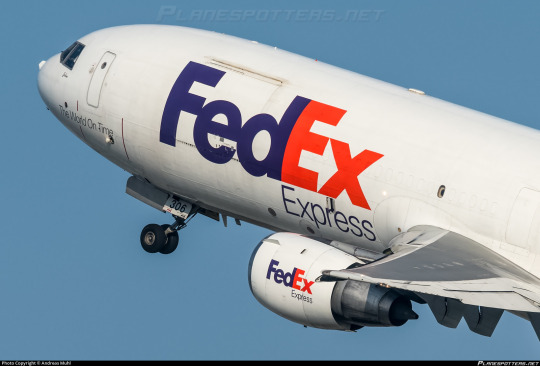
If you have ever sent or received a package, particularly if you live in the United States, you may be familiar with FedEx, and @magic-gps requested that I discuss their airplanes!
FedEx (founded and formerly known as Federal Express) is a massive network for transportation of mail and cargo, and Federal Express Express (okay, no, I can't call it that, FedEx is legally the full name even though we all know what it's really short for) is its airborne branch, making up the largest cargo airline by fleet and freight tonnes conveyed in the entire world. Their largest customer is the US Postal Service, with whom they have an exclusive contract - any USPS air mail is carried by FedEx Express - but they also fly for countless other clients. They cover so much ground (air) that they not only have a dozen hubs but an additional SUPERHUB, located in Memphis. They're what DHL is for Europe but doing bigger numbers, and that's with UPS, Atlas Air, and Kalitta Air to compete with. Although they're based in the US, their website claims that their destinations include every US zip-code, plus "over 220" countries and territories. There are 195 internationally recognized countries at present. I don't think saying they fly everywhere is even really hyperbole at this point.
FedEx's fleet is massive and eclectic. They have the world's largest cargo fleet, with 650 planes (which are named by employees, frequently after their children). Add in FedEx Feeder, a second fleet of small propeller airplanes dry-leased to local carriers for use ferrying small loads to the full-size jets, and there's a total of 699 FedEx liveries in the skies with 88 more on order. They occupy whole swathes of tarmac. They're everywhere. Like snails after the rain.

Oh, and apparently this livery was designed by Lindon Leader (what a name) of Landor Associates, the prolific and highly regarded design firm responsible for hits like the SAS belly stripe livery and misses like JAL's two previous designs. I have higher standards for liveries that are just absolutely everywhere, so let's see if Landor was able to live up to them.
I'm going to be specifically talking about, because I presume this is what the requester meant, the livery FedEx adopted in 1994. The timeline of this is interesting, because the name of the airline stayed Federal Express until 2000, when the entire company rebranded from Federal Express to FedEx and added the redundant 'Express' to the airline's name. I've always thought that was very funny, and while that's charming to me I don't think I should be encouraging things like this. It's just sloppy and a bit weird to say.
Before they adopted the livery they did briefly trial a new logo. From 1991 to 1994 they had this!
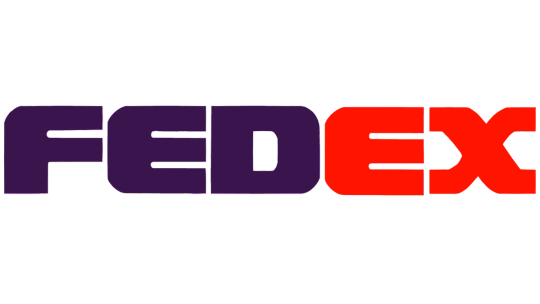
Boy do I not like that! It's significant to the history of the company in that it shifted the colorscheme from indigo and burgundy to purple and orange, except that the difference in brightness here is really almost upsetting and the logo itself is...it looks like that. It's very TRON somehow. I don't find the tackiness pleasant. It's just ugly. The typeface they chose is bad. The wriggly X is nice but every other letter looks a unique sort of hideous, with the E in particular looking like a rake made of sponge which has been placed in water and left to soak. Thankfully they moved on quickly, replacing this logo at the same time as their livery.
The fact that there's six years between the visual rebrand and official renaming is interesting. Federal Express was already colloquially known as FedEx before the official renaming, and used it in their branding, but they weren't legally FedEx yet, so for that little span their planes bore both names.
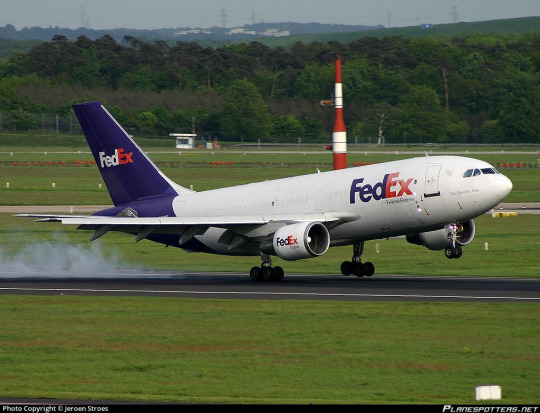

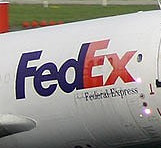
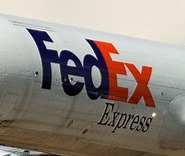
This adolescent period in the life of modern FedEx featured the 'Federal Express' subtitle in this serif mystery font which I haven't seen mentioned at all anywhere. I couldn't find many more pictures with the full 'Federal Express', but there's a scattering of seriffed planes out there, it seems. It looks a lot better with the 'Federal' taken out just by virtue of legibility, and I have to say I'm very keen on the way the subtitle is offset to align with the start of the E. It looks nice and aerodynamic. When the first word is taken out it has the extra benefit of lining 'Express' up with the 'Ex' that stands for it.
But there it is! The FedEx logo. Adopted in 1994, considered a contender for the best logo ever made, winner of over 40 awards.
I want to disclaim for a moment. I think it's always been somewhat implicit that my opinions are just one manifestation of the infinite variability of human thought and inevitably subjective but I do need to re-stress this now: these are my own hot takes. My opinion is not legally binding. Lindon Leader is an incredibly accomplished designer and I'm not even a designer at all. There is a reason that FedEx's logo is so widely acclaimed. My criticism of it is not an attempt to contest its legacy, and is - again - just my opinion. And it is an opinion colored not only by the fact that I'm an amateur, and by the fact that my tastes are different from other people's, but by the fact that this logo is quite literally older than I am, and tastes have most certainly evolved since then.
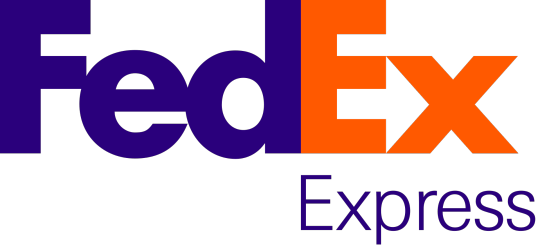
I think the FedEx logo is...okay. I certainly do not despise it, but I would stop very short of calling it the best logo ever. I'm going to talk about why I'm so underwhelmed by it, and it's going to sound like I don't like this logo for a bit, but if you power through that you will see that my opinion about it isn't as straightforward as the sum of my opinions about its parts.
The fantastic thing about this particular logo is that it's easily the most-discussed and best-documented bit of branding I've yet covered, so it was a delight to research. I didn't even have to call in my font wizard, for example, because Leader explicitly states what it is in this interview - a proprietary typeface heavily inspired by Univers 67 Bold Condensed and Futura Bold. I actually like Futura (the Cyrillic version is one of my favorite Cyrillic typefaces) but don't love Univers 67 - it reminds me way too much of the handwriting style I was drilled in at school. US schools have truly heinous taste in the penmanship they teach, and much like how Parker cursive inherently reminds me of third grade, Univers 67 feels to me like an adult version of something I've long since outgrown. The design of the letterforms here, with the exaggerated x-height and all the lines (crossbars included) having a uniform thickness of 'very', reminds me of the posters on the walls of elementary school classrooms.

Take a look at this. The green line is hypothetically where the baseline should be, but the E and D descend slightly below it. According to my font wizard this is fairly common as an attempt to some sort of visual trick, but I don't like it. I can make it out from a distance and it significantly bothers me.
Speaking of misaligned, I've always felt like the vertical line on the E was slightly wider than that on the D, but had dismissed this line of thought as an optical illusion - the darker color and the lack of detail at the top, plus the lack of gaps at any point in the E, artificially make the D look narrower than it is. I tried lining them up, and I was right, it's an optical illusion. I still hate it. What isn't an optical illusion is that the middle line on the E is thicker than the second line on the F - again, hate it!
And I just don't like this font! It's like if they fed different fonts to a neutral network and had it invent a weight bolder than bold, like the neural-network generated upperer and lowerer cases. I'm aware of the existence of ultra bold weights, and I'm not talking about those, because those are regular ugly and clearly made by humans. This looks like an algorithm expanded the letters until they were touching.
But the touching bit is intentional. The FedEx logo is hiding a little secret, perhaps the most frequently cited reason for why it's so beloved. Between the E and X, Leader slipped in an inconspicuous arrow.
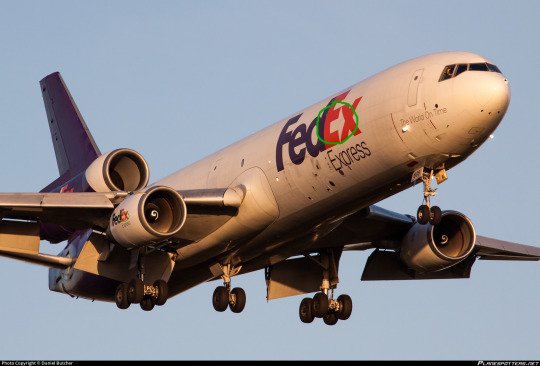
And I can't pretend this isn't really clever. It's subtle but once you see it you can never unsee it. My problem is that one feature doesn't make something good on its own, particularly when it's something you can easily miss at first. The Sneeze interview linked earlier sort of implies Leader built the font in large part around the idea of the arrow, and I find that a little problematic. Sometimes an idea is so fantastic you just can't let go of it, but when you're designing something you just can't be myopic like that. And, to be clear, I don't think Leader sacrificed the aesthetics of the wordmark to accommodate the arrow. I'm sure he personally thinks this font is beautiful. But when I evaluate it for myself, I can't allow one good feature to overpower my own dislike for the font overall, even if it is legitimately clever.
I do have some nice things to say, though. Well, mostly one nice thing. I love the color scheme. I think the purple and orange shades here are a wonderful choice, an uncommon one but one that manages to be a visually pleasing combination. If either of the shades were less saturated, or the purple were brighter, it would lose its cohesion, but Leader chose the perfect shades to bring out the best in each other. The old red and purple shades were absolutely hideous, but he transformed them into something great.
But at the end of the day my opinion of the logo on a granular scale is irrelevant. And I don't say that because I'm in the minority here or because I'm not allowed to have an opinion or anything else of the like. It doesn't matter because the FedEx logo is older than me and it is FedEx. When I see something purple and orange, I think of FedEx first. Let me use an example by invoking something better left dead.
In 2018 the Overwatch League, an esports league based around the maelstrom of poor decisions which is Blizzard's video 'game' Overwatch, played its first season. A charter member was the Florida Mayhem, a team which was in all honesty sort of a joke (though not exciting enough to live up to their name). I stopped following OWL after the first season, so I'm not sure if any of this has changed, but they finished second-to-last, made some very questionable choices on the management end, and were representing Florida. All of these facts are ontologically comedic. But above all, these were their team colors.
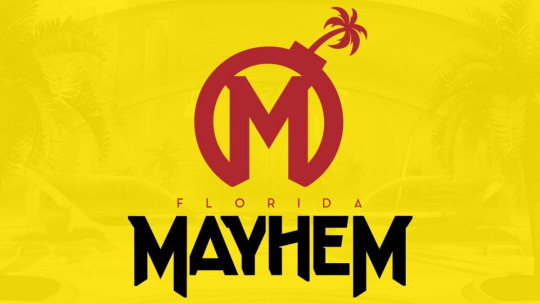

So, this creates the clear issue demonstrated above. Certain brands are so culturally entrenched that even a passing similarity in visual identity makes you immediately look like a pastiche, even if you're otherwise distinct. Mayhem's branding is, in my opinion, way better than McDonalds's, but it was still the right move when they changed to a completely unrecognizable color scheme in 2020. You just see some things and immediately recognize them.
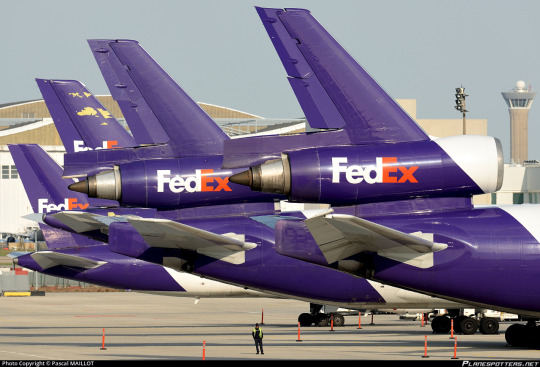
The cultural specter of the FedEx logo is very useful to the FedEx livery. As long as you do not royally mess up - which they have not - a FedEx plane will immediately resemble a FedEx package, even if it doesn't actually look like one, since they're mostly white.
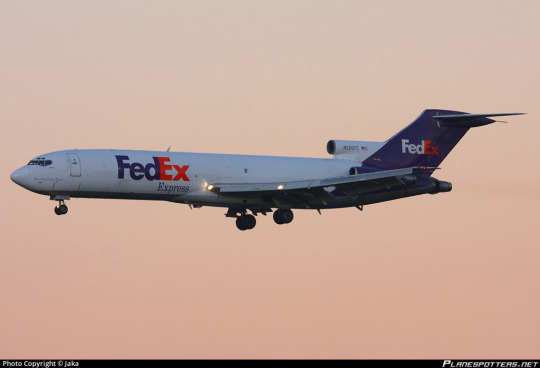
...well, okay, the planes are also mostly white. And I'll be honest, on the 727? This plane isn't half bad. The clean line of the t-tail makes this sort of straight-line-down livery look so much better, and the placement of the wordmark in front of the heavily swept wings keeps the white tube from looking quite so much like a white tube.
But the 727 isn't the only airframe they fly. They're the largest operator of six separate types, most of which are fully retired from passenger service, including the MD-11. Their MD-11s are literally the only trijets you'll see around in the US these days - they only started retiring their DC-10s in 2021, nearly ten years after they flew their last passenger flight. They're pretty unusual among large cargo airlines in that they flew the 747 for just over five years, and not particularly on their own initiative, having acquired a few from a merger with the Flying Tiger Line. So the way the livery looks on the 727 doesn't tell the whole story.
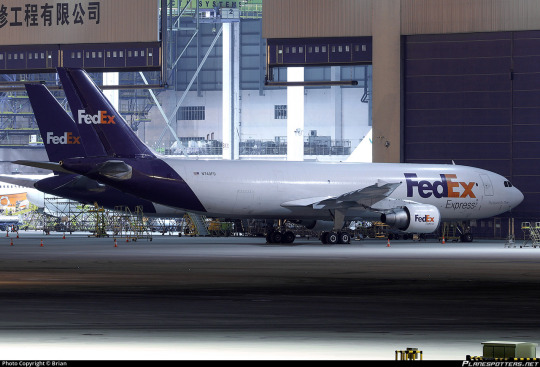
Okay. So that...is a couple of white tubes. That's somewhat unfortunate.
I want to clarify that, while this style of livery has become increasingly popular over time, culminating in its codification as an outright trend in the late 2010s and early 2020s, FedEx adopted this livery in 1994. It is wrong to say that the FedEx livery resembles TAM, Lufthansa, or Icelandair, and more correct to say that all of the above carriers are wearing a style similar to FedEx (though Qantas and MALÉV came first). Despite the fact that I've been known to call these 'Lufthansesque', Lufthansa didn't invent this style and didn't do it best. Still, doing it earlier doesn't excuse it.
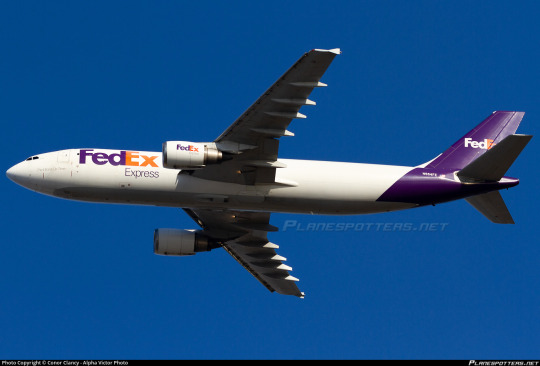
FedEx in particular suffers from the rear-heaviness issue. Though they have a larger logo which balances it out better than some (Lufthansa), it's kind of countered by the fact that FedEx exclusively operates planes I'd consider on the long and thin side. It makes the white look all the more dominant on the airframe.
FedEx does take one measure to mitigate this - the undersides are painted grey (in a style I've been calling 'Deltalike' to myself even though Delta absolutely did not do it first) instead of being the same white as the rest of the fuselage with the purple fully wrapping around. Also, they have the line remain straight on the third engine of trijets, instead of committing to one shade or the other, as older trijet liveries frequently did.
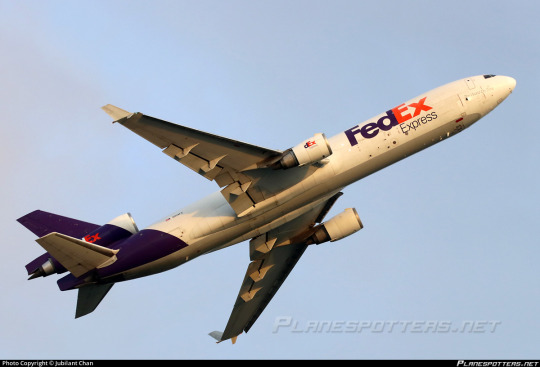

Compared to an ASL Airlines lease which keeps the underside white and the purple as a contiguous loop, this creates a much more streamlined look. But it's not enough to save this.
And I think what bothers me the most is how at odds this is with the thing people say is so brilliant about the logo - the arrow.
Arrows are, as Leader pointed out in his interview, definitely not a new phenomenon in airline liveries. Hell, we even had Arrow Air.

But there's a reason for that. Arrows represent forward movement. They're fundamentally indicative of speed, efficiency, and polish. And airplanes are more or less shaped like arrows, when you think about it.

Something being done very frequently doesn't make it somehow creatively bereft. And it's not like only painting the tail and the big of fuselage directly below it is reinventing the wheel either.
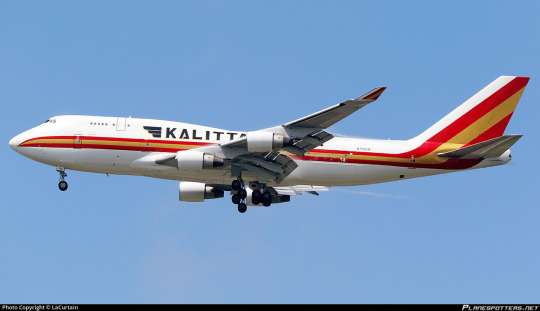
Cheatlines, and hockey sticks especially, were not a particularly new thing when my perennial example of 'boring idea, good execution', Kalitta Air, rolled out in the 1980s. In fact, they were done to death. But Kalitta Air's choice in color and shape, use of proportions, and stylish logo set it apart from every other airline to use this style.

There is a reason arrows are so common. They are speed and precision and kinetic energy. When you refuse to consider making something common your own, you often shoot yourself in the foot. With the logo constructed, with the motto 'the world on time' written on the nose of each plane, absolutely nobody would turn up their nose at FedEx having an arrow motif on its livery.

Ultimately, I'm a bit sad, because the FedEx logo, while I don't like a lot of the choices made in regards to the font, would provide a truly fantastic jumping off point for a livery that would elevate it beyond the point anyone could ever dismiss it as being part of a crowd of very similar designs, the way I have by lumping it in with Lufthansesques. Arrows, being a fundamentally long and tall shape, would also avoid the pitfalls of a livery type which I have already on multiple occasions critiqued for inherently creating a look of rear-heaviness, particularly on longer and thinner airframes, especially when the color used is a dark shade to contrast a white base.
That said, the FedEx livery gets a bit of a free pass where something like Lufthansa doesn't. FedEx's logo is so ubiquitous that unless you actively interfere with or muddle it, any plane bearing it will immediately be recognizable as a FedEx plane the same way a truck or package is. As a branding exercise it is certainly successful. It looks clean, it's by no means exceptionally ugly, it does its job...but it is so rich with potential and so impoverished in execution. Doesn't it just look like this plane isn't taking off, but being pulled by the weight of its purple slice towards the ground?

I'm giving FedEx a D+.
I don't feel good about doing this. I think this is an opinion which is not only contentious but downright unpopular. But as I've mentioned a few times my grades take into account more than just broad aesthetic appeal. Branding and environment factor in, but what also factors in is, as I said in discussing Saudia, wasted potential and a refusal to capitalize on what you have that's clearly good. When I graded Air Astra down for not reaching its potential I meant it as a kind gesture, not even a sort of tough love but an acknowledgment that I like what they have and I know they'll do better.
FedEx, however, is just disappointing. For the frequently cited best logo of all time, this is just unacceptable. This verdict brings me no joy, but the fact that this logo is so beloved doesn't mean I can go easy on it - to the contrary, it had a lot to live up to, and it just didn't.
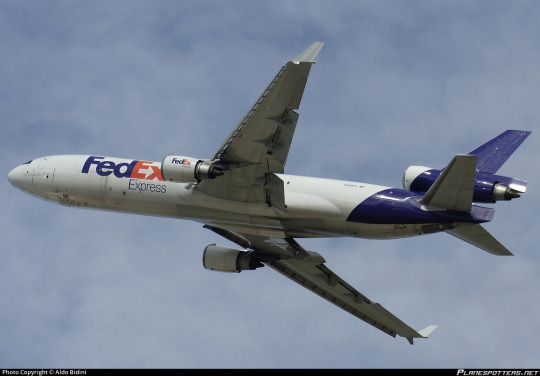
#tarmac fashion week#grade: d+#era: 1990s#era: 2020s#era: 2010s#era: 2000s#region: north america#region: united states#fedex#kalitta air#cargo carriers#requests#lufthansa line#landor portfolio#skywriting
28 notes
·
View notes
Text
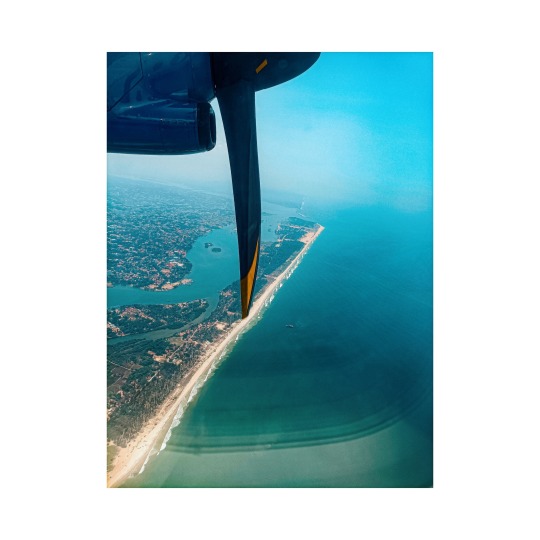
Coastal Aerial Vistas: A Glimpse from Indigo Flight over Mangalore
Flying over picturesque landscapes has always been an exhilarating experience, but nothing quite compares to the awe-inspiring beauty of coastal regions. The city of Mangalore, located on the pristine shores of the Arabian Sea in southern India, offers an extraordinary blend of natural splendor and vibrant culture. As I recently embarked on a journey with Indigo Airlines, I had the privilege of witnessing breathtaking coastal aerial vistas that left me speechless. Join me as I recount this remarkable journey and share the indelible impressions etched in my memory.
The Aerial Perspective:
As the Indigo flight soared into the skies above Mangalore, my heart raced with anticipation. The view from above provided an entirely new perspective of the coastal city. From the airplane window, I was treated to a panoramic tapestry of vivid blues and greens, where the cerulean waters merged seamlessly with the lush greenery of the surrounding landscape. The aerial vantage point revealed a coastline dotted with palm-fringed beaches, winding rivers, and estuaries that stretched far into the distance.
Coastal Charm:
The coastline of Mangalore is a true testament to the splendor of nature. From high above, I witnessed the rhythmic dance of waves crashing against the shorelines, leaving trails of foamy white surf in their wake. The sandy beaches, basking in the warm sunlight, beckoned visitors with their promise of tranquility and relaxation. The vibrant hues of parasols dotted along the shoreline added a playful touch to the otherwise serene scene.
As the aircraft cruised over the city, I marveled at the blend of old-world charm and modern development. The historic buildings, painted in vibrant colors, stood as proud reminders of Mangalore's rich heritage. Meanwhile, the city's rapid growth was evident in the sprawling urban landscape and the bustling port area, which served as a lifeline for trade and commerce.
Natural Wonders:
Beyond the city limits, the coastal region of Mangalore revealed its true natural wonders. The flight granted me a privileged view of the lush mangrove forests that fringe the riverbanks. These ecologically rich habitats serve as sanctuaries for numerous bird species and play a vital role in preserving the delicate coastal ecosystem.
Further inland, I witnessed the majestic Western Ghats mountain range rising like a sentinel, its peaks shrouded in a mystical haze. These ancient mountains are a treasure trove of biodiversity, hosting an incredible array of flora and fauna. The verdant valleys, nestled between the mountains, seemed untouched by time, inviting adventurers and nature enthusiasts to explore their hidden trails.
Conclusion:
My journey with Indigo Airlines provided an extraordinary opportunity to witness the unparalleled beauty of Mangalore's coastal vistas from the skies. The picturesque landscapes, the mesmerizing hues of the Arabian Sea, and the blending of nature and culture left an indelible mark on my soul. From the aerial perspective, I gained a deeper appreciation for the fragile balance between human development and the preservation of natural wonders.
Whether you're a seasoned traveler or a wanderlust-driven dreamer, I highly recommend experiencing the coastal splendors of Mangalore from the heights of an airplane. Let the gentle breeze against your face and the breathtaking vistas unfold before your eyes. It is a glimpse of paradise that will forever remain etched in your heart.
So, the next time you embark on a journey, choose the window seat, fasten your seatbelt, and prepare to be captivated by the coastal aerial vistas that await you on an Indigo flight over Mangalore.
3 notes
·
View notes
Text
Dystopian Omegaverse AU: Transportation
Transportation
Transportation is regulated by the Ministry of Transportation, led by Senator Harvey Harrison. He limited the amount of cars on the road to reduce traffic and put emphasis on public transport for the lower ranks, excluding Omegas.
Standardized
Cars are divided into eight categories divided by color. The cars with a black license plate are government officials, from the Council to the Senate. The red ones are Omegas, usually traveling with their pups or minders. The blue ones are the clergy. The white ones are conglomerates, corporate executives, and other high-ranking businessmen. The green ones are military officials, either Alpha, Delta, or Beta Plus. The gray ones are young unmarried Alphas or Alpha pups. The purple ones are doctors, surgeons, and medical specialists. Private taxis can be used by Deltas, Gamma Pluses, Beta Pluses, and Titanium visitors. They have a yellow license plate.
Public transportation is only available to Beta Neutral, Minuses, and Gamma Minuses. Their trains, buses, trams, trolleys, and ferries are colored based on their rank, such as teal, indigo, and dark purple. There is always a Gamma Minus operating them. Minuses from Betas and Gammas can ride bikes when they need to. They can not have their own private cars or call in taxis.
Railway service is divided into six. “Whitehaven Train Line” is for Alphas and Omegas. “Marble Coast Line” is for Delta and Gamma Pluses. “Silver Wall Branch Line” is for Delta Minuses and Beta Pluses. “Hope Meadows Line” is for Beta Neutrals. “Flower Gardens Line” is for Beta Minuses and Gamma Minuses. “Golden Palace Branch Line” is for tourists.
The bus and train stations are decorated with flowers and murals depicting propaganda art. Bus stops are full of PSAs, propaganda, announcements from the Ministry of Transportation, news, maps, commercials, and information regarding festivals or visits.
Sol Fertilis has two airlines. One is called “Aeris Solaris Airways”, mainly used for Alphas, Omegas, their households, Delta Pluses, and Gamma Pluses. The other is called “Nexum Airlines”, mainly used by Delta Minuses, Beta Pluses, Neutrals, Minuses, and Gamma Minuses. Also, Aeris Solaris Airways can be available to Diamond and Titanium visitors as Nexum Airlines are available to Silver and Gold visitors.
Deltas, Beta Pluses, and Neutrals can have their own cars.
Omegas are not allowed to take public transport, drive cars, walk on their own, or ride bicycles. They can only go in chauffeured cars, luxury sleeper train cars, and first class sections of Tranquility Airways. Whenever they need to walk, they must walk with their Maid and/or Companion or, if they are unmated, with another unmarried Omega. It’s recommended that they do this five times weekly.
Specialized
These forms of transportation are used for the transport of Droughters, Omegas, tourists, pups, and doctors with nurses.
The Droughter buses are orange prison buses, meant to take them from the Drought Lands to either the Savage Zoos or the Menegerie.
The van that are used to transport “rescued” untamed Omegas are known as the “Wine Van”. It usually have Tamers with Omegas from the Drought Lands or had disguised as Gamma Minuses. They are usually drugged inside as the van drives to the Pink Center.
Unmated Omegas would travel in red vans, with the Omega symbol on it.
Tourists would travel in yellow tour buses with a Beta Minus tour guide and a Gamma Minus driver.
Pups from the Centers would travel in coach buses, each divided by color and rank.
Ambulances would be brightly colored with blue and purple. They are further divided to emergency, non-emergency, buses, psychiatric, and birthing. The birthing ambulances would be in front of households or birthing places in case there is a need of urgent care for either the parent or the newborn.
#dystopian omegaverse#Sol Fertilis#omegaverse au#transportation#omegaverse#dystopia#dystopic#dystopian
5 notes
·
View notes
Text
Ahmedabad to Delhi Flights: Everything You Need to Know Before You Travel
Ahmedabad to Delhi flights connect two of India’s most prominent cities, offering convenience and efficiency for travelers. Whether it’s a business trip or a leisurely getaway, understanding the nuances of this route can make your travel experience seamless and enjoyable.
Flight Options on the Ahmedabad to Delhi Route
The Ahmedabad to Delhi route is one of the busiest in the country, serviced by several airlines including IndiGo, SpiceJet, Air India, and Vistara. With multiple daily flights, travelers have a range of options to choose from, including budget and premium carriers.
Duration and Distance
The distance between Ahmedabad and Delhi is approximately 950 kilometers. Ahmedabad to Delhi flights typically take around 1.5 to 2 hours, making it a quick and hassle-free journey.
Booking Your Flight
To secure the best fares, book your Ahmedabad to Delhi flights early. Airlines frequently offer discounts during off-peak travel times, and booking at least a month in advance is recommended. Fare comparison websites can help you find the best deals.
Airport Information
Ahmedabad’s Sardar Vallabhbhai Patel International Airport is well-connected to various parts of the city, making it convenient for travelers. In Delhi, the Indira Gandhi International Airport offers excellent connectivity to the city center and surrounding areas through taxis, metro services, and buses.
What to Expect In-Flight
Depending on the airline you choose, Ahmedabad to Delhi flights may offer amenities like complimentary snacks, meals, or in-flight entertainment. Budget airlines may have a no-frills approach, so plan accordingly if you need extra services.
Best Time to Fly
Morning and evening Ahmedabad to Delhi flights are the most popular among business travelers. If you’re looking to save money, opt for midday or late-night flights, which are often less crowded and more affordable.
Tips for a Smooth Journey
Check-In Online: Save time at the airport by checking in online and choosing your preferred seat.
Arrive Early: Arrive at least two hours before departure to complete security checks and boarding comfortably.
Stay Updated: Keep an eye on flight updates via the airline’s app or website to avoid last-minute surprises.
Exploring Delhi After Your Flight
Delhi offers a plethora of attractions, from historical landmarks like the Red Fort and Qutub Minar to bustling markets like Chandni Chowk. With easy connectivity from the airport, you can dive straight into exploring the city after your Ahmedabad to Delhi flight.
Conclusion
Ahmedabad to Delhi flights provide an efficient and affordable way to travel between two dynamic cities. With a plethora of options and amenities, you can tailor your journey to suit your preferences. Plan your trip today and enjoy a seamless travel experience!
#Ahmedabad to Delhi flights#bengaluru to varanasi flight#bengaluru to bagdogra flight#amritsar to goa flight#chennai to dehradun flight#mumbai to varanasi flights#ahmedabad to bhubaneswar flight
0 notes
Text
Delhi to Goa Flights: Your Gateway to Sun, Sand, and Sea
The bustling streets of Delhi and the laid-back beaches of Goa are worlds apart, yet seamlessly connected by frequent flights. If you’re dreaming of leaving the capital behind for a dose of sunshine, sea breeze, and unforgettable vibes, here’s everything you need to know about booking a flight from Delhi to Goa.
The Popularity of the Route
The Delhi to Goa route is one of India’s busiest domestic travel corridors, serving leisure seekers, honeymooners, and adventure enthusiasts. With a flight duration of just 2.5 to 3 hours, this journey is the fastest way to swap the chaos of city life for Goa’s relaxed charm.
Airlines Flying from Delhi to Goa
Numerous airlines operate on this route, offering both budget and premium travel options:
IndiGo
Air India
SpiceJet
Go First
Vistara
With multiple daily flights, you’ll find a schedule that suits your plans, whether you’re heading for a weekend escape or an extended vacation.
Delhi to Goa Flight Details
1. Airports
Departure: Indira Gandhi International Airport (DEL)
Arrival: Dabolim Airport (GOI), located in Vasco da Gama, Goa.
2. Flight Duration
A direct flight takes approximately 2.5 hours, making it a quick and convenient travel option.
3. Frequency
Flights are frequent, with multiple options spread across the day. Early morning and late-night flights are perfect for budget-conscious travelers, while midday options suit those who prefer a relaxed start.
Tips for Booking Delhi to Goa Flights
1. Plan Ahead
While Goa is a year-round destination, demand spikes during peak tourist seasons:
November to February: For the pleasant weather and vibrant festivals like Christmas and New Year’s Eve.
April to June: For budget-friendly deals and fewer crowds. Book early to secure the best fares, especially during the winter season.
2. Compare Prices
Use flight comparison tools like Skyscanner, Google Flights, or MakeMyTrip to find the best deals. Look out for discounts and festive offers.
3. Pack Smart
Goa’s tropical climate calls for lightweight clothing, sunscreen, and beach essentials. Avoid overpacking; Goa is all about keeping it casual!
Beyond the Flight: Getting Around in Goa
Once you land at Dabolim Airport, you’ll need transportation to your destination. Popular options include:
Taxis: Prepaid or app-based options like GoaMiles.
Self-Drive Rentals: Scooters and cars are widely available for exploring at your own pace.
Local Buses: Affordable but less convenient for tourists.
Why Choose Goa?
1. Beaches and More
From the lively shores of Baga and Calangute to the serene sands of Palolem and Morjim, Goa’s beaches cater to every mood.
2. Culture and History
Explore Old Goa’s UNESCO World Heritage churches, vibrant flea markets, and Portuguese-inspired architecture.
3. Adventure and Nightlife
Try water sports like parasailing and jet-skiing during the day, and dance the night away at iconic clubs like Tito’s and Silent Noise.
The Ultimate Escape
A Delhi to Goa flight isn’t just a journey; it’s the start of a transformation. As your plane descends over Goa, the sight of azure waters and swaying palms signals that you’ve arrived in paradise. Whether you’re here to party, relax, or discover Goa’s rich heritage, the memories you create will last a lifetime.
So why wait? Book your flight, pack your bags, and let Goa’s sun-soaked shores welcome you with open arms.
0 notes
Text
IndiGo ADAPT Preparation at Top Crew Aviation! 🛫✨ Get the skills and confidence to excel in your aviation career 🚀👨✈️👩✈️
Indigo, pilot, pilot training, preparation, aviation, journey, dream, success, life, achievement, interview, adapt, Air India, vistara, Tata, Ambani, Adani, simulator, viral, new post, video, real, captain, pilot, airline, journey,
#topcrewaviation #aviation #pilotlife #captainpkumar #pilottraining #flyhigh #aviationtraining #aviationdreams #aviationcareer #similatör #indiaaviation #indigo #airlinepilot #airindia #delhi #jaipur #career #prepration #newpost #newreels #newreel
#topcrewaviation#aviation#pilottraining#pilotlife#pilot#dgcaexams#aviationgeek#dgca#topcrewaviationschool#captainpkumar
0 notes
Text
IndiGo has launched a direct connection between Bengaluru and Mauritius, marking its 35th international route. The airline will operate four weekly flights on this new path, offering a quick, five-and-a-half-hour journey. Source [ad_2] Source link
0 notes
Text
The one destination stations of IndiGo
IndiGo – the country’s largest airline has been growing rapidly in terms of both fleet, reach and expanse since 2018. I have often described the airline’s network and station selection as “find a station such that you can bombard it with flights from multiple different places’ ‘. This largely held true for its narrowbody network until it started flights in the North East and subsequently last…
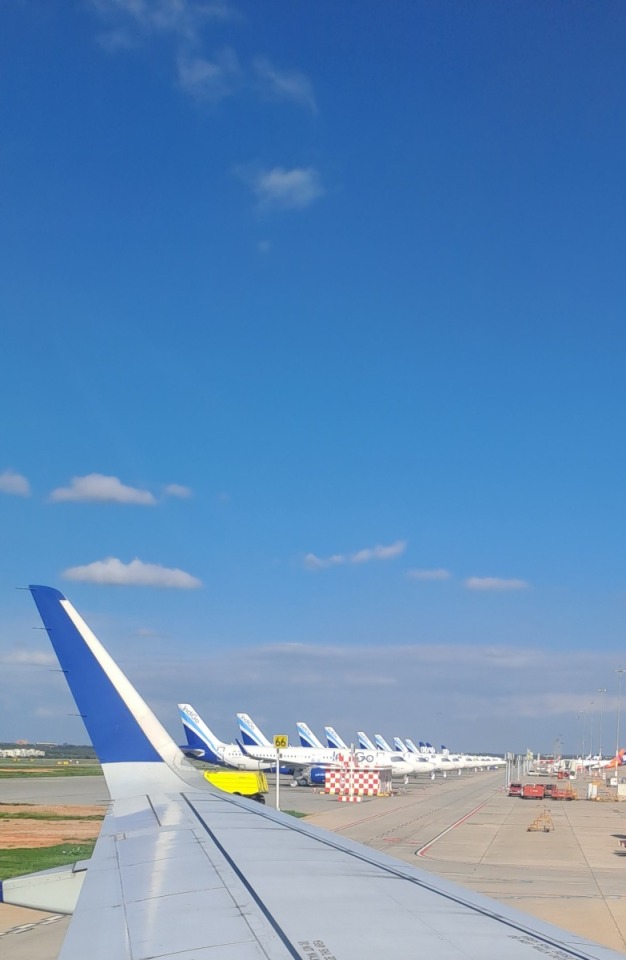
View On WordPress
#Aviation Blogs#Indian Aviation#Indian aviation blogs#Indian aviation news#IndiGo#IndiGo airline network analysis#IndiGo airline one flight stations#IndiGo network
0 notes
Text
IndiGo has launched a direct connection between Bengaluru and Mauritius, marking its 35th international route. The airline will operate four weekly flights on this new path, offering a quick, five-and-a-half-hour journey. Source [ad_2] Source link
0 notes
Text
Boost Your Travel Business with an Advanced Airline Ticket Booking Portal

Travel companies are adopting cutting-edge technology in today's hectic environment to streamline their operations and deliver top-notch client service. A key tool that improves productivity and creates a smooth ticket purchase experience is an airline ticket booking portal. Top airlines like IndiGo, Vistara, Air India, SpiceJet, and Akasa Air are accessible to travel brokers through platforms like Fly24hrs, allowing them to provide their customers with unmatched services.
This blog will walk you through what an airline ticket booking portal is, how it works, and how leveraging leading airlines' unique features can drive your travel business to new heights.
What is an Airline Ticket Booking Portal?
An online tool that links airlines and travel agencies and provides convenient ways to search for flights, compare prices, and buy tickets is called an airline ticket booking portal. Using Fly24hrs, agents benefit from:
Real-time flight schedules and updates.
Access to multiple airlines, catering to diverse customer needs.
A user-friendly interface that ensures quick and accurate bookings.
How Does an Airline Ticket Booking Portal Work?
Fly24hrs integrates directly with airline systems, delivering a hassle-free booking experience:
Access Real-Time Flight Information: Stay updated with the latest schedules and fares from top airlines like Vistara and IndiGo.
Search and Compare Flights: Explore flight options across airlines such as SpiceJet, Akasa Air, and Air India to find the best deals for your clients.
Book and Manage Tickets: Effortlessly complete bookings and manage reservations, saving valuable time.
Highlighting Top Airlines Available on Fly24hrs
Let’s take a closer look at the airlines accessible on the Fly24hrs platform and their standout features:
1. IndiGo
A leader in India’s aviation market, IndiGo is known for:
A vast domestic network reaching tier-2 cities and major hubs.
Excellent on-time performance for hassle-free travel.
Budget-friendly fares, making it a go-to choice for price-conscious travelers.
2. Vistara
For tourists looking for first-rate experiences, Vistara provides:
India’s first premium economy seating.
Top-notch in-flight amenities, including gourmet dining.
A growing international network ideal for business and luxury travelers.
3. Air India
Air India, India's flag carrier, blends history with wide-ranging international connectivity:
An extensive network to Europe, the Americas, and Asia.
A rewarding frequent flyer program.
Spacious seating and full-service options, perfect for long-haul travel.
4. SpiceJet
SpiceJet is renowned for offering high-quality, reasonably priced services.
Competitive pricing for budget travelers.
SpiceMAX and other upgraded seating options are more comfortable.
A strong domestic and regional network.
5. Akasa Air
Akasa Air, a more recent arrival, is revolutionising domestic travel by:
Modern aircraft for quieter, more comfortable journeys.
Eco-friendly practices for sustainability-focused travelers.
Affordable pricing that appeals to young and dynamic customers.
Why Choose Fly24hrs for Your Travel Business?
Fly24hrs is solely focused on providing travel agents with a booking platform that is easy to use and customised to meet their needs. It's the ideal business partner for the following reasons:
Save Time: Purchase tickets from several airlines, such as SpiceJet or Air India, without having to visit several websites.
Increase Revenue: To draw in more clients, provide affordable tickets from airlines like IndiGo and Akasa Air.
Provide Variety: Offer a variety of choices to suit different tastes, from deluxe Vistara experiences to more affordable solutions.
How to Use the Fly24hrs Portal
Getting started with Fly24hrs is simple:
Register: Make an account on the website.
Log In: To access the portal, enter your login information.
Search Flights: Enter your travel information and look through flights offered by airlines such as SpiceJet and Vistara.
Compare Options: Choose the best alternative for your clients by comparing fares and itineraries.
Book Tickets: Fill out the reservation and pay securely.
How Travel Agents Benefit from Fly24hrs
Fly24hrs provides travel brokers with a number of benefits:
Increased Efficiency: Easily manage several reservations.
Diverse Offerings: Give clients choices from a variety of leading airlines, ranging from low-cost options like Akasa Air to high-end services like Vistara.
Enhanced Credibility: For precise and prompt reservations, rely on a reliable website.
Conclusion: Fly24hrs – Your Trusted B2B Flight Booking Partner
Fly24hrs offers a comprehensive solution to streamline the booking process for travel agents wishing to improve their offerings. Fly24hrs helps agents to build their companies and provide better customer service by collaborating with leading airlines like IndiGo, Vistara, Air India, SpiceJet, and Akasa Air.
Are you prepared to revolutionise your travel company? Sign up with Fly24hrs now to see the difference!
#cheap flight ticket#b2b travel agent portal#flight booking online#b2b flight booking portal in india#b2b flight booking engine#best b2b travel portal#travel agent ticket booking portal#b2b portal
0 notes